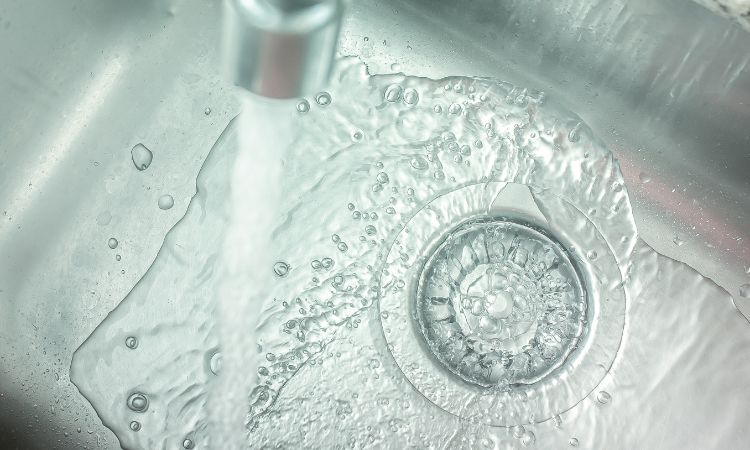We've come across this great article about Three Common Ways to Fix a Slow Drain below on the web and decided it made perfect sense to share it with you over here.

Introduction
We've all existed: You're cleaning your teeth or washing your hands, and you discover the water merging in the sink. As opposed to quickly swirling down the drain, it lingers, turning your once-refreshing morning routine into a miniature overload scene. A slow-draining sink isn't simply irritating; it's commonly a sign of larger pipes problems prowling under the surface area. The bright side is that the majority of slow-draining sinks can be repaired with a little expertise, a couple of basic tools, and some perseverance. All set to tackle this project head-on? Allow's roll up our sleeves and dive right in.
Comprehending the Reasons For a Slow-Draining Sink
Prior to you start poking around in your pipes, it assists to know what could be causing the stagnation. Comprehending the root cause makes it much easier to choose the ideal fix.
Usual Culprits Behind Slow Drain
So, what's obstructing points up? Generally, it's a combination of everyday particles-- assume hair, soap scum, toothpaste residue, and leftover food fragments. In time, these tiny bits collect and hold on to the pipeline wall surfaces, slowly narrowing the flow and making it harder for water to pass through. Sometimes, natural resource from tough water can additionally add to the crud, producing the perfect storm for persistent blockages.
When is it Time to Take Action?
If you observe the water draining slower than normal, it's a great idea to intervene faster instead of later on. Waiting also long could cause complete clogs, unpleasant smells, or perhaps pipeline damage. If the water takes greater than a few seconds to clear out after shutting off the tap, consider it a warning and prepare to put on your do it yourself hat.
Tools and Products You'll Need
The right devices make all the difference. The good news is, you will not require a fully equipped plumbing's van to finish the job.
Important Devices for Do It Yourself Services
A plunger is your go-to beginning factor. A tiny, sink-sized plunger produces suction that can dislodge small blockages. For even more persistent clogs, a drain serpent (in some cases called a plumbing technician's auger) works wonders. A pair of gloves, a flashlight, and perhaps a pair of protective safety glasses are likewise helpful.
Suggested Cleaning Solutions
Mild dish soap and warm water can aid break down oily accumulation. A blend of baking soda and vinegar is a time-tested natural remedy, and enzymatic cleansers offer a more environment-friendly strategy. Maintain chemical drain cleaners as a last hope, as they can be extreme on your pipelines.
Safety First: Preventative Measures and Prep work
Prior to you launch into unclogging setting, consider safety. You're managing possibly dirty water and particles, so slip on a set of gloves. If you're using chemical cleansers, make sure the area is well-ventilated and follow the instructions on the tag.
Protective Equipment and Office Configuration
Set some old towels or dustcloths around the sink area to capture dashes. Eliminate any products that could enter your means, like soap dispensers or toothbrush owners. Make sure you have excellent lighting-- order a flashlight if required.
Step-by-Step Overview to Dealing With a Slow-Draining Sink
Currently, allow's get involved in the nitty-gritty. This step-by-step process will certainly guide you via easy strategies to restore your sink's drainage.
Step 1: Get Rid Of and Tidy the Stopper
Typically, the stopper (that small plug you push down to obstruct water) is the initial offender. Remove it very carefully and clean off any hair or gunk entraped around its base. Rinse it completely before placing it back in place.
Action 2: Use a Bettor to Remove Particles
Got that plunger all set? Setting it over the drainpipe and give it a few company pumps. The idea is to produce suction that can loosen up any type of clog. If you see littles debris floating up, you're on the right track.
Step 3: Try a Drain Snake or Cord Wall Mount
If the plunger doesn't suffice, it's time to bring out the drain snake. Delicately feed it right into the drainpipe and twist as you go. You could feel some resistance-- that's likely the clog. Maintain turning and pulling up until you get rid of the blockage. If you don't have a drain serpent, a straightened wire hanger can work in a pinch.
Tip 4: Apply a Do It Yourself Drainpipe Cleaner
An all-natural cleaner made from baking soft drink and vinegar can break down residual crud. Pour half a mug of baking soft drink into the drainpipe, complied with by half a mug of vinegar. Let it fizz for around 15 minutes, after that flush with warm water. This chemical reaction usually does wonders for small obstructions.
Step 5: Rebuild and Evaluate the Sink
Placed every little thing back together and run the faucet. Does the water currently swirl down the drain at a reputable rate? If yes, give yourself a pat on the back. Otherwise, don't despair-- there are still a few more tricks up your sleeve.
Alternative Techniques for Stubborn Clogs
Not all blockages are produced equivalent. If your sink still declines to coordinate, think about these different services.
Sodium Bicarbonate and Vinegar Technique
We already touched on this, but it deserves keeping in mind once again. This gentle, environmentally friendly technique is safer than chemical cleaners and usually rather reliable.
Chemical Drainpipe Cleansers
Enzyme-based cleaners use natural microorganisms to digest organic matter. They're a superb selection if you're looking to avoid harsh chemicals. Just remember, they might take a bit longer to function their magic.
Chemical Drain Cleaners: Benefits And Drawbacks
Chemical cleaners can blow up through tough clogs quickly, yet they're not without drawbacks. They can produce warmth and fumes, damages pipelines if utilized exceedingly, and present environmental dangers. Use them moderately, and constantly follow the instructions very carefully.
Safety Nets to Keep Your Sink Flowing
Prevention is the best remedy. By taking on a couple of easy practices, you can maintain your sink from slowing down to begin with.
Normal Cleaning Up Routines
Wipe down the sink basin and component area on a regular basis. Get rid of hair or food fragments prior to they have a possibility to wash down the drain.
Avoiding Hazardous Materials Away
Think twice before discarding coffee premises, grease, or coarse vegetable scraps down the sink. These culprits hold on to pipe wall surfaces, developing clogs in time.
Routine Upkeep Checks
Schedule a fast regular monthly evaluation. Run warm water with the sink for a couple of mins, taking note of the circulation. If it appears slow-moving, act quick prior to it comes to be a full-on blockage.
When to Call an Expert Plumber
Sometimes, despite exactly how hard you try, that block just will not budge. That's when it's time to generate the pros.
Indications That Show a More Major Problem
If your sink drains pipes gradually in spite of multiple efforts, or if you see water supporting in various other fixtures (like your shower or toilet), you might have an extra severe plumbing issue lurking much deeper in the system.
Balancing DIY Efforts with Professional Assistance
While DIY can save you money and provide a feeling of accomplishment, there's no embarassment in calling a specialist. A professional plumbing professional can assess your whole plumbing arrangement, guaranteeing there's no underlying damages or long-term trouble that could cost you extra down the road.
Contrasting Expenses and Long-Term Solutions
Prior to deciding, consider the big picture. An inexpensive, quick fix might resolve the trouble temporarily, yet investing in a much more permanent remedy can save you money and stress and anxiety in the long run.
Weighing the Costs of Do It Yourself vs. Professional Repairs
Do it yourself fixes commonly cost little bit more than the price of a bettor or a container of cooking soft drink. Specialist services, on the other hand, included a cost yet may avoid repeated concerns and expensive repairs later on.
Investing in Top Quality Fixtures and Upgrades
If your sink's style contributes to constant blockages, it could be worth upgrading to higher-quality fixtures or altering the pipes format. Consider this an investment in your house's capability and comfort.
Final thought
A slow-draining sink can seem like a small irritability, but it's commonly an indicator that your pipes requires a little tender loving care. By understanding the source, utilizing the right devices and techniques, and committing to straightforward preventive measures, you can keep your sink moving openly. And when all else fails, never ever wait to contact an expert-- your home's plumbing deserves the financial investment in treatment and upkeep.
Three Common Ways to Fix a Slow Drain
Baking Soda Method
Boil a full pot of water. Measure out cup of baking soda and pour it down the drain. Then take cup of the magical cleansing substance known as white vinegar and drop that down there too. Allow the mixture to fizz in the drain for five minutes as the vinegar and baking soda combine. Now dump in that whole pot of boiling water. This combination of cleaning substances should clear out anything that is causing your sink to drain slowly. If it doesn t...
Zip-It
If the baking soda method doesn t clear out your drain, it may be because a significant amount of hair and/or other debris has collected there and you need to remove it. Purchase a Zip-It tool at any home improvement or hardware store and insert it into your drain. It will catch any collected hair or debris that s blocking the flow of water. Pull it out. If it s got a big clump of hair, etc. on the end, you ve probably got your culprit.
Drain Cleaner
If these methods don t work, there is the standard drain cleaner that you can also buy in a hardware store or even your local grocery store. It s better if you can use a household solution, but these drain cleaners often work in a pinch. They re very simple to use. You generally just dump them in your drain and wait. If even this method is not effective, it may be time to call the plumber.
https://www.mrrooter.com/oneida/about-us/blog/2017/july/three-common-ways-to-fix-a-slow-drain/

Do you appreciate reading up on How to Fix a Slow Draining Sink? Try to leave feedback directly below. We would be glad to listen to your insights about this write-up. We hope that you visit us again later on. Are you aware of somebody else who is sincerely interested in the subject? Take a moment to share it. I love your readership.
Get An Estimate
 Alana "Honey Boo Boo" Thompson Then & Now!
Alana "Honey Boo Boo" Thompson Then & Now! Jeremy Miller Then & Now!
Jeremy Miller Then & Now! Marcus Jordan Then & Now!
Marcus Jordan Then & Now! Lucy Lawless Then & Now!
Lucy Lawless Then & Now! Terry Farrell Then & Now!
Terry Farrell Then & Now!